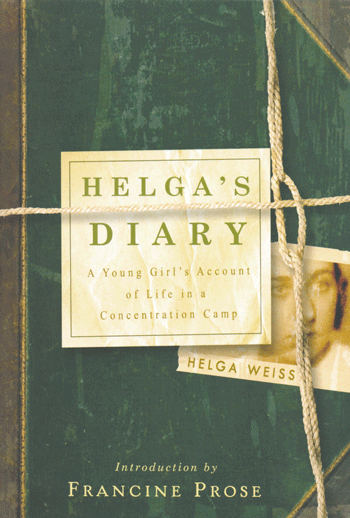Helga’s Diary: A Young Girl’s Account of Life in a Concentration Camp, by Helga Weiss, W.W. Norton, 240 pages, $24.95
Reviewed by NEAL GENDLER
Three years in Terezin had made adolescent Helga Weiss shrewd enough to lie about her birth year as she neared the pointing SS man on Auschwitz’s arrival platform.
She was 15, but seeing children being sent to the left, she quickly figured she needed to say 1926 to be 18 and go to the right with her mother.
Of 15,000 children brought to Terezin and later deported to Auschwitz, Weiss is one of 100 known to have survived. Her illustrated diary, concealed in a Terezin wall by an uncle and retrieved after the war, is fascinating, a youth’s contemporaneous view of life and death in the purported model concentration camp the Germans called Theresienstadt.
It’s intriguing to read her matter-of-fact statements about her middle-class family’s constricting life in Prague after Germany’s 1939 invasion. For example, she enrolls in a small class of Jews expelled from public school. Friend Eva is in another, and “at 3 — the time Jews are allowed to shop — we’ll buy some school supplies.”

The book charms with a youthful guilelessness that quietly becomes worldly. Knowing the larger story, we still can startle at the little things. Sick with encephalitis, she must have her mattresses and duvet disinfected and then bathe.
“That will be wonderful,’ she says. “A bath, for the first time in three years.”
Helga and her parents leave home on Dec. 7, 1941, for deportation to Terezin, an old fortress town crammed with Jews from Czechoslovakia and later elsewhere. Acute overcrowding, poor food and inadequate sanitation create epidemics including typhus. Helga feels responsible for her sometimes-ill mother.
Sexes are separated. In a children’s barracks, Helga makes friends, attends secret classes and finds amusements such as competing to kill bedbugs. People sustain themselves by stealing food during field work and communicate with illicit notes.
Trembling, Helga describes something that “if I hadn’t seen it with my own eyes, I would not have believed that today, in the 20th century, something like this could happen”: nine young men carrying shovels to dig their graves, condemned for sending notes to their mothers.
Waves of prisoners arrive and others are deported, thousands at a time. Helga watches her father’s last wave before he’s swept into a crowd headed for trains to Auschwitz on Oct. 1, 1944. It hurts to realize how close he — and so many — came to surviving.
Three days later, Helga and her mother are sent, the train rushing at frightening speed as if racing to deliver its cargo to the death factory before the Russians can close it.
In Auschwitz’s hell, a rare admission of despair: Amid a shelf of starving women packed so tightly that an individual cannot turn over, she asks: “Oh, God, why are you punishing us like this?”
She calmly reports events that include cruelty for its own sake: leaving coats inside while working outdoors in cold weather, shaving heads for infractions such as full-body washing, and standing for hours of “roll calls,” in rain or snow, wearing only striped prison uniforms.
Helga and her mother are moved to Freiberg, Germany, for 12-hour days in an aircraft factory and eventually to Mauthausen, her mother gaunt by the time of liberation.
Returning to Prague, they eventually get back their — stripped — prewar apartment, where Helga still lives. By 1946, she puts together the post-Terezin portion as though it had been written in its time. She makes up for lost schooling and begins a career of painting and then teaching art.
Helga’s Diary includes photos and her drawings of Terezin life.
An introduction by Francine Prose and a 2011 interview by translator Neil Bermel explain Weiss’ postwar life and bringing the diary to publication. Helga says keeping it all in present tense is appropriate.
Teaching about her experience is physically and psychologically damaging, she says, because “when I talk, I relive it; I’m still in it. So it’s still the present, even though it’s the past. And it’s just as vivid.”
***
Neal Gendler is a Minneapolis writer and editor.
(American Jewish World, 4.26.13)



















